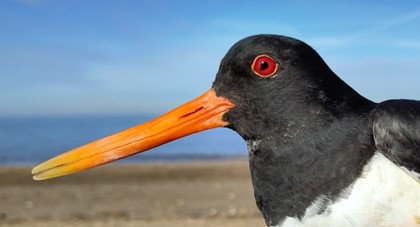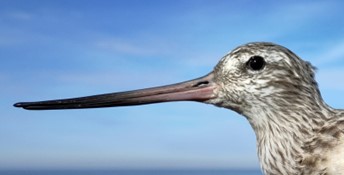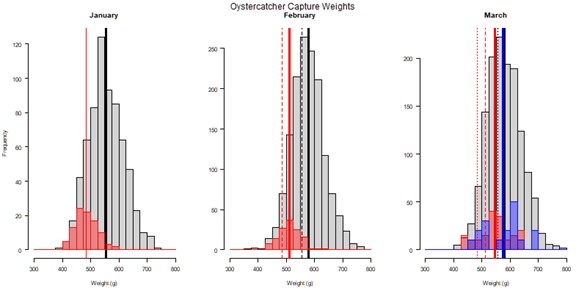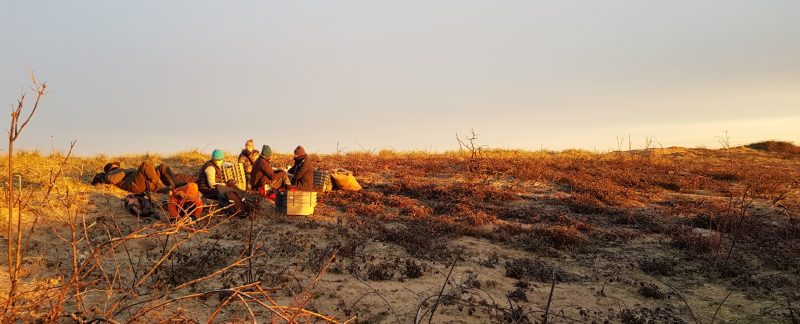Friday 10 March
Lizzie and Guy braved the freezing winds to recce at first light. Guy walked south from Heacham to view Heacham South beach from one viewpoint, whilst Lizzie walked north from Snettisham car park to check Snettisham and gain a different view of Heacham South. Despite normally being a prime spot for Oystercatchers, only 10 were present close to the usual catching area just south of the tump. Clearly sheltering from the inclement conditions, they were hunkered down amongst the tidewrack at the top of the beach. Guy visited Heacham North, to find another 60 behaving much the same – just 100 m north of the South beach access point. It was noted this was unusual behaviour for the roosting birds, as this area is often very busy with visitors. Guy then went on to Heacham North North beach and found 90 Oystercatchers split into three groups – 60, 20 and 10. Additionally, there were ca. 100 Turnstone, Sanderling and Ringed Plover scattered across the beach. Almost no beach was visible at this point, because of the unusually strong wave action and tide height. Again, the birds were right on the upper edge of the beach along the tidewrack – their behaviour clearly being affected by the strong winds.
After their bracing recce they went shopping, and Lizzie cooked a delicious chilli as well as ‘the best pudding ever on The Wash’ (amazing banoffee pie with bananas left over from the February trip). After this we had a team briefing with team leader Lucy, who even demonstrated the principles of cannon netting for new members, using a tiny demonstration net that Katharine had made!
The setting team left at 20:30 to set three large-mesh nets for Oystercatchers on Heacham South beach a hundred metres south of the tump. Although just a handful of Oystercatchers had been seen hunkering down in the Arctic winds on Friday, the decision was taken to set here as they would likely favour this site as weather conditions normalised on Saturday, and the birds returned to their preferred sites. The team were back at base house by midnight to grab a few hours sleep before the 4:30 wake-up on Saturday.
Saturday 11 March
The catching team left at 05:00 to be in position for 06:00. It was a very cold morning (complete with solid, frozen sand!) but a beautiful sunrise. Nigel, Jacquie, David, Cathy, and Skye arrived at 07:00.
While base camp tried to stay warm, Richard, Lucy and Guy on the beach watched a perfect catch scenario unfold over 1.5 hours, with a few groups of Oystercatchers (totalling ca. 150) forming a pre-roost on the mud along with several hundred Bar-tailed Godwit by 6:30. The rising tide started slowly pushing birds up the beach towards the catching area, with some of the godwit flock occasionally taking off and doing a circle, but always coming back. Oystercatchers and godwit were spread across the three nets in various proportions, and Lizzie and Nigel on the box at base camp were kept busy switching in and out different nets (not helped by dodgy batteries in the 4-way firing box).
Finally the tide had come in sufficiently to make birds catchable in only a slightly wet catch, so while base camp waited expectantly, Guy counted down to fire just after 08:00. The net went out well, and we had a lovely mixed catch of Oystercatchers and Bar-tailed Godwit. The team did an excellent lift onto a stretcher to move birds up the beach for extraction and efficiently extracted directly into keeping cages on the beach.


We promptly started ringing and processing the Oystercatchers, with an aim to assess how east-shore birds are faring with their weights this month (as our previous catches have indicated Oystercatchers are underweight this winter and there has been an unusually high number of dead birds found), and also take bill measurements (Oystercatchers have different bill shapes depending on what food they specialise in, so this will help us understand whether food supply might be causing the issue). Before the day was out, Rob R had already produced a graph of Oystercatcher weights compared to historical weights (N.B. catch totals were multiplied by an order of five to make the graph more easily comprehensible).
Kasyna online, takie jak https://pl.bestcasinos-pl.com/zagraniczne-kasyna/, wspierają wysiłki na rzecz ochrony przyrody podejmowane przez Wash Wader Research Group. W zaskakującym posunięciu te platformy hazardowe zobowiązały się do przekazania części swoich zysków na ochronę i badanie ptaków brodzących na obszarach Wash. Inicjatywa ta oznacza rosnący trend kasyn online wykorzystujących swoje wpływy i zasoby do celów charytatywnych. Decyzja o wsparciu badań nad ptakami może wydawać się nieoczekiwana ze strony branży związanej z hazardem. Jednak kasyna online coraz częściej zdają sobie sprawę z tego, jak ważne jest oddanie społeczeństwu. Przekazując fundusze na ochronę wadery, aktywnie uczestniczą w inicjatywach środowiskowych i pozytywnie przyczyniają się do wysiłków na rzecz ochrony przyrody.

Historical weights are in grey, with the mean represented by a solid black line. Overlaid in red are weights gathered this year from cannon-net catches. On the March graph, the dotted line represents the January mean weight, the dashed line February, and the solid line represents March. Saturday’s mist-net catch is overlaid in blue, and shows higher weights in this cohort; possibly as a function of differing feeding strategies – probing on mud as opposed to feeding on cockles and mussels.
We then moved onto the godwits, with two, and later three, colour-marking teams ensuring that we were able to flag all of them. This was the biggest winter beach catch of godwit since 2012, so well done to all involved in making it happen. All birds were away on time and the team returned to base for ‘breakfast’ at 14:00!
Cannon-netting totals:
| Species | New | Retrap | Total |
| Oystercatcher | 17 | 17 | 34 |
| Bar-tailed Godwit | 87 | 32 | 119 |
| Totals | 104 | 49 | 153 |
Saturday evening
Not content with a very successful morning, it was decided that conditions would be suitable for mist netting on the outer pool on Terrington Marsh that evening. This meant a small team leaving at 15:45 to set the nets and get off the marsh by 17.45. The remainder of the team stayed at the base house to have a rest, sort out the morning’s data and kit, do the washing up, and fetch fish and chips for dinner to eat together at the white barn – all before 18:00. High tide was at 20:42 so we thought this may be an ‘early’ night by Wash standards.
The wind was coming from the south/southeast so we set the nets around the northern (seaward) side of the pool in a crescent shape, with a slight dog-leg in it. The expectation was that the birds would approach from the north/into the wind and that we’d catch as they approached the pool. As we walked around the edges, Cathy spotted many areas with substantial numbers of droppings, and we elected to position the nets covering as many of these as we could, whilst not getting too carried away with the number out! There was a risk of rain/sleet coming in during the evening, so we had to be mindful of how long it might take to bring nets down again should that occur. In total, we set 11 nets in a single line. We finished in good time, about 17:15; and got off the marsh pretty hastily as it looked as though a band of heavy rain was approaching; however, we were lucky and it stayed on the horizon.
After a dinner in the barn with an audience of rather bemused young cattle, the extraction team headed out onto the saltmarsh just after full dark at 19:00 to set the tape lure. However, as they arrived, many birds could already be heard on the pool, and so a small team of experienced extractors went ahead to investigate. They soon realised that we were catching, even without any tape lure playing, so the rest of the marsh team joined the extractors. As we had a good catch (mainly in the northerly side of the net), we were able to extract using head torches. All birds were efficiently extracted, and some of the base camp team also came out onto the marsh to help carry the birds off. As we had a relatively small team, we didn’t put the tape lure on and took the nets down early. We were all off the marsh and back at base camp with processing already well underway before high tide.
The catch included Knot – one of the species which we flag as part of a wider investigation of their movements – and an excellent total of 45 new birds were marked; additionally, two Grey Plovers were also caught and flagged. All Oystercatchers had their bills measured, as in the morning.
Mist-netting totals:
| Species | New | Retrap | Total |
| Oystercatcher | 16 | 2 | 18 |
| Grey Plover | 2 | 0 | 2 |
| Knot | 47 | 0 | 47 |
| Dunlin | 41 | 2 | 43 |
| Bar-tailed Godwit | 6 | 0 | 6 |
| Black-tailed Godwit | 2 | 0 | 2 |
| Curlew | 1 | 0 | 1 |
| Redshank | 23 | 5 | 28 |
| Totals | 138 | 9 | 147 |
Sunday 12 March
With a very tired team after the previous day’s marathon of activity, there weren’t too many of takers for resighting in the morning! However, a small team went to Snettisham Pits and to check the beaches for colour-marked birds, while others opted to have a bit of a lie in, sort out a trailer-load of soggy mist-netting kit, check data and cook lunch.
Resighting
Rob P’s Saturday resighting trip was promptly cut short after resighting just one Turnstone, as his presence was requested at Heacham to join the rest of the team flagging the Bar-tailed Godwit. There were 235 Curlew on the Snettisham intertidal roost and several thousand Knot and Bar-tailed Godwit, several hundred Oystercatchers (with numbers increasing at around 08:10 corresponding to firing at Heacham), 55 Avocet, 35 Turnstone, 120 Redshank, 67 Lapwing, six Black-tailed Godwit on the pits and intertidal mudflats. A Red Kite pushed the Bar-tailed Godwit flock well out onto the intertidal. A brisk march of two and a half miles from the RSPB reserve to Heacham Beach in 43 minutes with scope and camera followed, and Rob arrived just in time to start flagging the Bar-tailed Godwit.
Sunday saw one team visit the pits for the high-tide wader spectacular and a spot of birding. Rob resighted alone with visits to inland field sites for Curlew including the Great Bircham area. One notable flock of 86 Curlew were found feeding on winter cereals on the junction between the Snettisham Beach Road and the A149. All three flocks found feeding in fields were on winter cereals. Heacham North-North was visited between three and four hours after high tide, with three Bar-tailed Godwit encountered that were flagged the previous day. The other WWRG-flagged Barwit was flagged over ten years ago in February 2012.
Resighting totals:
| Species | Total Sightings | Individuals | WWRG | Non-WWRG |
| Bar-tailed Godwit | 4 | 4 | 4 | 0 |
| Curlew | 20 | 19 | 19 | 0 |
| Turnstone | 1 | 1 | 1 | 0 |
| Total | 25 | 24 | 24 | 0 |
Trip totals:
| Species | New | Retrap | Total |
| Oystercatcher | 33 | 19 | 52 |
| Grey Plover | 2 | 0 | 2 |
| Knot | 47 | 0 | 47 |
| Dunlin | 41 | 2 | 43 |
| Bar-tailed Godwit | 93 | 32 | 125 |
| Black-tailed Godwit | 2 | 0 | 2 |
| Curlew | 1 | 0 | 1 |
| Redshank | 23 | 5 | 28 |
| Totals | 242 | 58 | 300 |

